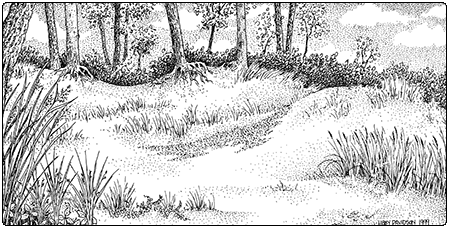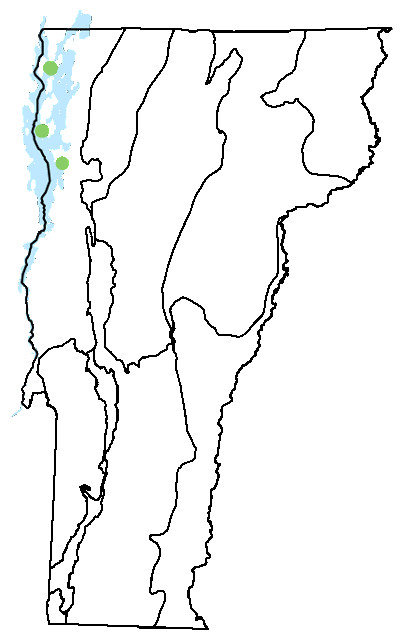Ecology and Physical Setting 
When the Champlain Sea occupied the Champlain Valley 12,800 to 9,000 years ago, sand was abundant—thousands of tons had been carried in on rushing glacial meltwater, and currents were moving it around. New sand was being formed all the time by constant wave action cutting into rocky shores. Fossil beaches from that time can be found well above the current lake level in Colchester, Milton, and other towns in the Champlain Valley. Today, shores are more stable, and humans have worked hard to tame the sands. But sand is still available and is moving naturally throughout the lake, forming and maintaining natural beach and dune systems.
Dunes are defined by sand movement. Water moves sand, depositing it on beaches at high water. Winds move the sand landward, sculpting it up into high hills and shaving those same hills down again. Prevailing summer winds in the Champlain Basin come from the south. Water and wind move south to north much of the time. Dunes and beaches are therefore most likely to be found on south-facing shores, and in fact all the largest Vermont examples fit that pattern. A typical setting for a dune-beach complex is a very flat, south-facing shore with a long, unimpeded reach to the south.
 Sand Dunes are a rarity in Vermont, found in only a few scattered localities on Lake Champlain. They are small in comparison with dunes on the Atlantic Coast or on the Great Lakes, and all of Vermont’s known examples are at least somewhat altered, as they are prime recreational areas. Because there are no undisturbed dunes in Vermont, their physical and vegetational characteristics cannot be fully known.
Sand Dunes are a rarity in Vermont, found in only a few scattered localities on Lake Champlain. They are small in comparison with dunes on the Atlantic Coast or on the Great Lakes, and all of Vermont’s known examples are at least somewhat altered, as they are prime recreational areas. Because there are no undisturbed dunes in Vermont, their physical and vegetational characteristics cannot be fully known.
Natural Sand Dunes are sometimes mimicked by human disturbance. The valleys of the Lamoille and Winooski Rivers are especially sandy, and nineteenth century agriculture caused the exposure of large areas of sand there, creating blowouts of sometimes immense proportions. In the 1930s, many of these areas were planted with pines to stabilize the soils, but blowout areas can still be seen on the hills above those rivers. The blowouts are very similar to natural dunes, with tiger beetles moving about and slender-stemmed flatsedge growing in the sand. The difference is that, given time, the blowouts will become completely vegetated once again.
Vegetation
Vegetation on a Sand Dune community is sparse. Woody plants are scattered, but in general do not thrive under the rigorous conditions of drought and constant wind. Perennial and annual herbs are mixed. A few plants that have adapted to windblown, oceanic shores do well in these habitats, and many plants that have adapted to other kinds of disturbance, human as well as natural, are also successful. Champlain beach grass, beach pea, and beach heather all became established in the Champlain Basin during the time of the Champlain Sea and have persisted here on shifting sands for the 9,000 years since freshwater returned to the basin.
Wildlife Habitat
Tiger beetles are typical inhabitants of Vermont’s small sand dunes. Tiger beetles are so named for their behavior during their larval stage, when they live just an inch or so under the surface of the sand at the bottom of a vase-shaped pit. Other insects that pass near enough the pit fall in, with the help of the unstable sand, and are quickly devoured. Adults are identified by their habit of jumping about on the sand and their extreme speed when running down prey. The open sand is the appropriate habitat for the very rare hairy-necked tiger beetle, but this species has not been found in Vermont dunes for many years. The more abundant common shore tiger beetle is found in Sand Dunes and several other shoreline communities.
Related Communities
- Lake Sand Beach: Sand Dunes are always associated with Lake Sand Beaches. Sand Dunes occur landward of Lake Sand Beaches and have deeper sand deposits. Certain plants such as slender-stemmed flatsedge, parasol sedge, and cottonwood can be found in both communities.
Conservation Status and Management Considerations
Natural Sand Dunes are rare in Vermont. They are restricted to Lake Champlain because no other lakes are large enough to have sufficient wind and wave action to form dunes. Most dunes have been altered by human activity, including the building of seasonal homes, sand mining, and use by off-road vehicles.
Owners of natural dunes can preserve them by building elsewhere, on more stable ground, prohibiting off-road vehicle use, and allowing sand to move naturally through them.
Vermont’s most intact Sand Dune system is protected at Alburgh Dunes State Park, and efforts are ongoing to restore the natural functioning of that system. Other Sand Dunes are in private ownership.
Distribution/Abundance
Only a handful of Sand Dunes are known in Vermont, and all are on Lake Champlain. Larger inland Sand Dunes are associated with the Great Lakes.
Characteristic Plants
Trees
Gray birch – Betula populifolia
Quaking aspen – Populus tremuloides
Red maple – Acer rubrum
Cottonwood – Populus deltoides
Herbs
Champlain beach grass – Ammophila breviligulata ssp. champlainensis
Sand dropseed – Sporobolus cryptandrus
Groundnut – Apios americana
Parasol sedge – Carex umbellata
Common horsetail – Equisetum arvense
Slender-stemmed flatsedge – Cyperus lupulinus var. macilentus
Evening primrose – Oenothera biennis
Poison ivy – Toxicodendron radicans
Sandbur – Cenchrus longispinus
Non-native Plants

more common beach grass found along the east
coast and Great Lakes.
Coastal beach grass – Ammophila breviligulata ssp. breviligulata
Big brome – Bromus inermis
Downy chess – Bromus tectorum
Quackgrass – Elymus repens
Butter-and-eggs – Linaria vulgaris
Timothy – Phleum pratense
Rare and Uncommon Plants
Beach pea – Lathyrus japonicus
Champlain beach grass – Ammophila breviligulata ssp. champlainensis
Beach heather – Hudsonia ericoides ssp. tomentosa
Hay sedge – Carex siccata
Beach wormwood – Artemisia campestris ssp. caudata
Tuckerman’s witchgrass – Panicum tuckermanii
Associated Animals
Common shore tiger beetle – Cicindela repanda
Rare and Uncommon Animals
Hairy-necked tiger beetle – Cicindela hirticollis
Places to Visit
Alburgh Dunes State Park, Alburgh, Vermont Department of Forests, Parks, and Recreation
